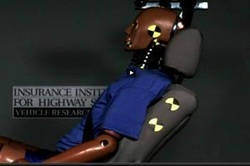 Many people are under the mistaken impression that the head-sized extension at the top of your car’s seat is a head rest. It’s actually not a place to rest your weary head during a long drive, but rather a safety feature called a head restraint that is there to help prevent whiplash in the event of a rear-end collision. And having it adjusted properly can mean the difference between emerging unscathed and enduring weeks of neck pain, along with the cost and inconvenience of medical treatment. Whiplash is the most common type of injury in an auto accident. The Insurance Bureau of Canada has conducted studies showing that the proper use of head restraints can reduce the incidence of whiplash by as much as 40%. Russ Rader of the U.S. Insurance Institute for Highway Safety (IIHS) explains what happens when you are involved in a rear end collision: “The head restraint is designed to work with your vehicle’s seat; it keeps your body and head moving together. The problem comes in if your head lags behind your body and snaps backward. That’s what leads to neck injury, or what’s commonly known as whiplash. Modern head restraints are designed to prevent whiplash, and that’s why they’re so much taller than they used to be.”
One problem is that some people find the newest head restraint designs to be uncomfortable. Some of the common complaints from users at Automedia.com include this one from the owner of a Volkswagen Jetta: “The front headrest points so forward that I get neck pain after just a few miles of driving.” Then there’s this one from a Subaru owner: “Unless you enjoy your face aiming toward your crotch, you may not be able to find a comfortable position for the headrest or your head.” One of the reasons for the above complaints is that, in order to get good reviews from the IIHS (many people check the IIHS’s ratings for vehicles before they purchase a car) and comply with the regulations established by the Federal Government for head restraints, auto manufacturers must provide head restraints that meet specific criteria. In particular, the head restraint must be no more than 2.2 inches from the driver’s head and it must be two or more inches higher than was previously required. A head restraint can prevent whiplash only if it is as close to your head as possible when a collision happens. When hit from behind, your head snaps quickly backward, then forward, which causes the muscles and tendons in the neck to overstretch and tear. If the head can’t snap back very far, there is much less chance of an injury occurring. Most head restraints adjust upward and downward, and some also tilt forward and back. The best position for a head restraint is one in which the head is as close to it as possible, ensuring it is no more than two inches away. The top of the head restraint should ideally be even with the top of your head and should never be any lower than your ears. Taking just a little time and effort to position your head restraint correctly can save you a lot of pain and suffering if you are ever in an auto accident. Your health and safety are worth it!
0 Comments
Leave a Reply. |
AuthorPosted by Dr. Babak Missaghi Archives
August 2017
Categories
All
|

 RSS Feed
RSS Feed
